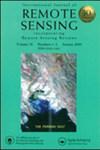确保COMS/MI和GK-2A/AMI反照率产品一致性的人工智能方法
IF 1.5
4区 地球科学
Q3 IMAGING SCIENCE & PHOTOGRAPHIC TECHNOLOGY
引用次数: 0
摘要
摘要基于卫星的地表反照率数据被广泛用于监测和分析全球气候和环境变化。韩国持续利用通信海洋气象卫星(COMS)/气象成像仪传感器(MI)和GEO-KOMPSAT-2A (GK-2A)/先进气象成像仪传感器(AMI)检索地表反照率。然而,由于算法、输入数据和分辨率的差异,这些地表反照率输出的质量有所不同,这限制了它们作为气候数据的长期使用。通过分析COMS/MI和GK-2A/AMI地表反照率数据的误差并进行校正,可以加强气候的连续监测。本研究利用多元线性回归(MLR)、随机森林(RF)和深度神经网络(DNN)模型,考虑各卫星反照率数据误差特征,建立了基于机器学习的校正模型。采用表现最好的射频模型进行校正。校正后的射频COMS/MI数据误差减小;经现场数据验证,COMS/MI的均方根误差(RMSE)由0.056提高到0.023,与GK-2A/AMI的均方根误差(RMSE)为0.019相似。在GLASS卫星数据的时间序列验证中也显示出稳定性,平均RMSE为0.036。关键词:Surface AlbedoGK-2A/AMICOMS/MIAERONETGLASSCorrectionMachine learning披露声明作者未报告潜在利益冲突。本文档中的英语已由至少两名以英语为母语的专业编辑检查过。(http://www.textcheck.com/certificate/iFW2k3)Additional信息)本工作由韩国气象局研究与发展计划“利用气象卫星进行天气预报支持和辐合服务的技术开发”基金(KMA2020-00120)资助。本文章由计算机程序翻译,如有差异,请以英文原文为准。
An ai approach to ensuring consistency of albedo products from COMS/MI and GK-2A/AMI
ABSTRACTSatellite-based surface albedo data are widely used to monitor and analyse the global climate and environmental changes. Korea continuously retrieves surface albedo from the Communication, Ocean and Meteorological Satellite (COMS)/Meteorological Imager sensor (MI) and GEO-KOMPSAT-2A (GK-2A)/Advanced Meteorological Imager sensor (AMI). However, the quality of these surface albedo outputs differs due to differences in the algorithms, input data and resolution, which limits their long-term use as climate data. By analyzing errors in the surface albedo data from COMS/MI and GK-2A/AMI and applying corrections, continuous climate monitoring can be enhanced. This study developed a correction model based on machine learning using multiple linear regression (MLR), random forest (RF) and deep neural network (DNN) models to consider the albedo data error characteristics of each satellite. The best performing RF model was used for correction. The errors of the corrected RF COMS/MI data were reduced; when validated with in-situ data, the Root Mean Square Error (RMSE) of the COMS/MI improved from 0.056 to 0.023, similar to the RMSE of 0.019 of GK-2A/AMI. It also showed stability in the time series validation with GLASS satellite data, with a consistent mean RMSE of 0.036.KEYWORDS: Surface AlbedoGK-2A/AMICOMS/MIAERONETGLASSCorrectionMachine learning Disclosure statementNo potential conflict of interest was reported by the author(s).Notes1. The English in this document has been checked by at least two professional editors, both native speakers of English. For a certificate, please see: (http://www.textcheck.com/certificate/iFW2k3)Additional informationFundingThis work was funded by the Korea Meteorological Administration’s Research and Development Program “Technical Development on Weather Forecast Support and Convergence Service using Meteorological Satellites” under Grant (KMA2020-00120).
求助全文
通过发布文献求助,成功后即可免费获取论文全文。
去求助
来源期刊

Remote Sensing Letters
REMOTE SENSING-IMAGING SCIENCE & PHOTOGRAPHIC TECHNOLOGY
CiteScore
4.10
自引率
4.30%
发文量
92
审稿时长
6-12 weeks
期刊介绍:
Remote Sensing Letters is a peer-reviewed international journal committed to the rapid publication of articles advancing the science and technology of remote sensing as well as its applications. The journal originates from a successful section, of the same name, contained in the International Journal of Remote Sensing from 1983 –2009. Articles may address any aspect of remote sensing of relevance to the journal’s readership, including – but not limited to – developments in sensor technology, advances in image processing and Earth-orientated applications, whether terrestrial, oceanic or atmospheric. Articles should make a positive impact on the subject by either contributing new and original information or through provision of theoretical, methodological or commentary material that acts to strengthen the subject.
 求助内容:
求助内容: 应助结果提醒方式:
应助结果提醒方式:


